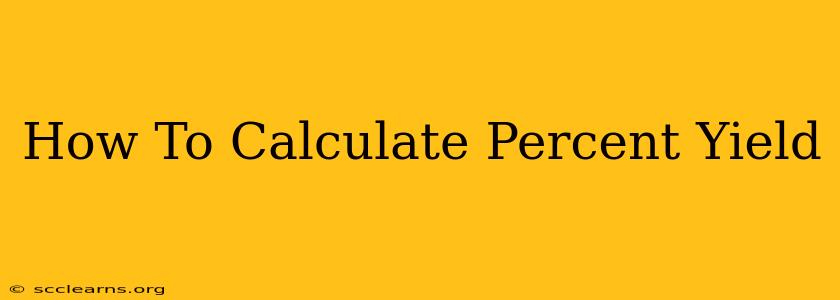Percent yield is a crucial concept in chemistry and other scientific fields that measures the efficiency of a chemical reaction. Understanding how to calculate it accurately is essential for analyzing experimental results and optimizing reaction conditions. This guide will walk you through the process step-by-step, providing clear explanations and examples.
Understanding the Components of Percent Yield Calculation
Before diving into the calculation itself, let's define the key terms involved:
-
Theoretical Yield: This is the maximum amount of product that could be formed in a chemical reaction, based on the stoichiometry (the mole ratios) of the balanced chemical equation and the limiting reactant. It represents the ideal outcome under perfect conditions.
-
Actual Yield: This is the actual amount of product obtained from the experiment. It's always less than or equal to the theoretical yield due to various factors like incomplete reactions, side reactions, and loss during purification.
-
Percent Yield: This expresses the efficiency of the reaction. It shows the ratio of the actual yield to the theoretical yield, expressed as a percentage.
The Formula for Percent Yield
The formula for calculating percent yield is straightforward:
Percent Yield = (Actual Yield / Theoretical Yield) x 100%
Step-by-Step Calculation of Percent Yield
Let's illustrate the calculation with an example. Consider a reaction where 10 grams of reactant A react to produce product B. The balanced chemical equation shows that 1 mole of A produces 1 mole of B. The molar mass of A is 50 g/mol, and the molar mass of B is 100 g/mol.
Step 1: Calculate the moles of reactant A
- Moles of A = (mass of A) / (molar mass of A) = 10 g / 50 g/mol = 0.2 mol
Step 2: Calculate the theoretical yield of product B (in moles)
- According to the stoichiometry, 0.2 mol of A will produce 0.2 mol of B.
Step 3: Calculate the theoretical yield of product B (in grams)
- Mass of B (theoretical yield) = (moles of B) x (molar mass of B) = 0.2 mol x 100 g/mol = 20 g
Step 4: Determine the actual yield
Let's assume that after the experiment, you obtained 16 grams of product B. This is your actual yield.
Step 5: Calculate the percent yield
- Percent Yield = (Actual Yield / Theoretical Yield) x 100% = (16 g / 20 g) x 100% = 80%
Therefore, the percent yield of the reaction is 80%. This means that the reaction was 80% efficient in converting reactant A to product B.
Factors Affecting Percent Yield
Several factors can influence the percent yield of a chemical reaction. These include:
- Incomplete reactions: Not all reactants may be converted to products.
- Side reactions: Unwanted reactions may consume reactants and produce unwanted byproducts.
- Loss of product during purification: Some product may be lost during the isolation and purification process.
- Reversibility of reaction: If the reaction is reversible, an equilibrium may be established, preventing complete conversion of reactants to products.
- Experimental errors: Errors in measurement or technique can affect the yield.
Improving Percent Yield
To improve percent yield, consider these strategies:
- Optimize reaction conditions: Adjust factors like temperature, pressure, and concentration to favor product formation.
- Use pure reactants: Impurities can interfere with the reaction.
- Minimize loss during purification: Use efficient purification techniques.
- Choose appropriate catalysts: Catalysts can accelerate the reaction and increase yield.
By understanding the calculation of percent yield and the factors that affect it, you can better analyze experimental results and optimize chemical processes for maximum efficiency. Remember to always carefully record your experimental data and perform calculations accurately to obtain reliable results.

